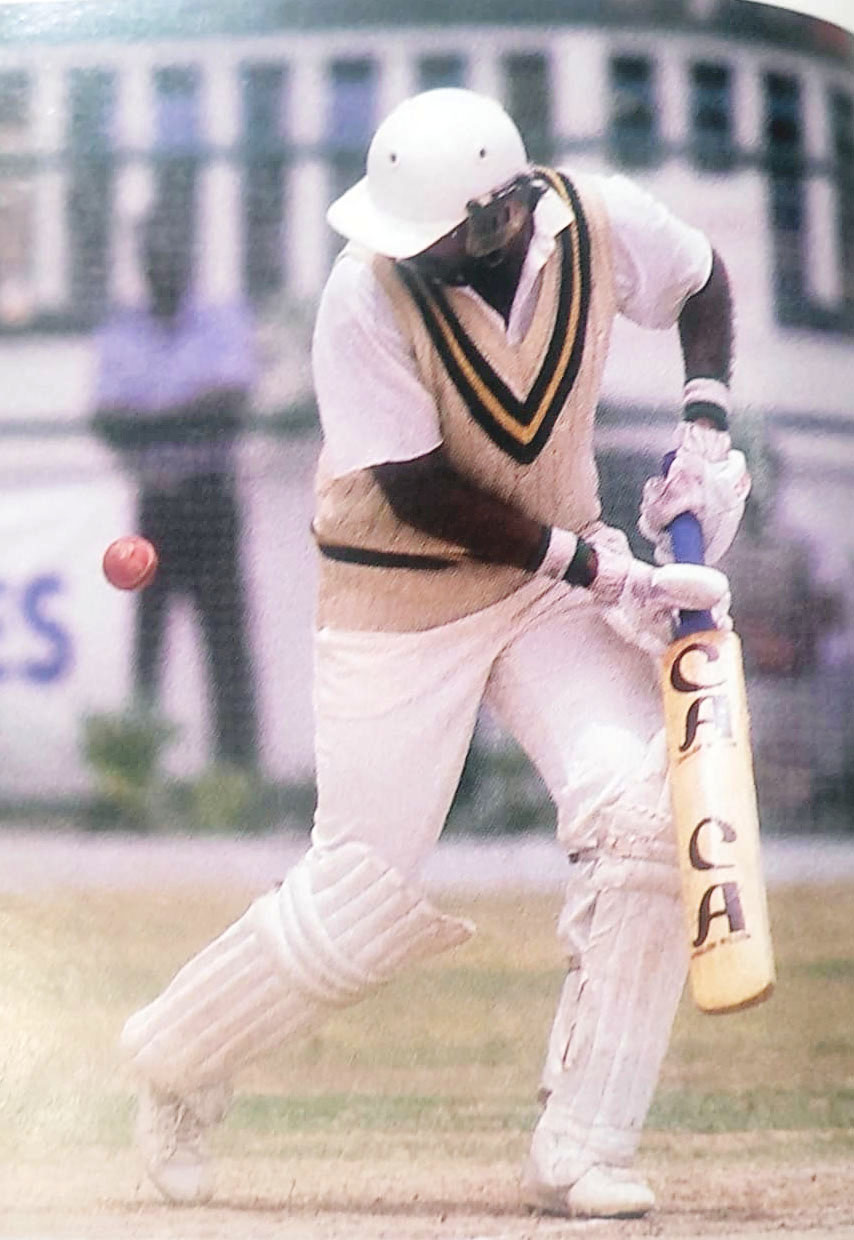Cable and Wireless Sponsorship
Prior to the start of the Pakistan tour, the West Indies Cricket Board of Control (WICBC) announced that Cable and Wireless (C&W), the international telecommunications company, which had been serving the Caribbean for over a century, would be sponsoring Test cricket in the region for the next four years to the tune of US$1 million, with annual injections of US$250,000 to be applied to tour expenses and prize money. The latter remunerations for the 1988 C&W Test series were: US$5,000 to the team winning the series; US$1,000 to the team winning each Test match; US$1,000 to the Man of the Series; US$250 to the Man of the Match for each Test.
“Test cricket is an expensive sport in the Caribbean, as both the visiting and home teams need to travel from island to island, usually by air, which clearly makes the cost of a Caribbean tour escalate,” Allan Rae, WICBC President (November 1981 – May 1988) observed. “The away tours and sponsorship keep West Indian cricket going. Without commercial backing Test cricket in the Caribbean would be in jeopardy.”
The stars align for Pakistan
If ever the West Indies were ripe for the picking during their unbeaten streak it was the 1988 Test series against Pakistan. After a succession of successes, where defeat was relatively unknown, the last three series, all away, had been shared 1 – 1; Pakistan (1986), New Zealand (1987), and India (1987). In the three prior series, the opposition had been blown away by 3 – 1, 2 – 0, and 5 – 0 margins.
In the preceding year, three valuable pillars of the ‘1977 – 1987’ West Indies teams announced their retirement from the Test arena: fast bowler, Michael Holding (60 Tests); middle order batsman, Larry Gomes (60); and fast bowler, Joel Garner (58). Gordon Greenidge, the opening stalwart, had had knee surgery (which had caused him to pull out from the 1987 World Cup squad, though he recovered in time for the Tour of India), and was increasingly prone to injury. Malcolm Marshall had opted out of both the World Cup and the Tour of India citing the need for a break from the game after years of non-stop cricket. (Marshall also played County Cricket for Hampshire). The West Indies still had lots of talent, both experienced and promising, but obviously were a team in transition as the ‘90’s beckoned.
On the eve of the First Test, the West Indies were greeted with the bad news that two leading players, Skipper Viv Richards and Marshall were unavailable. Richards, still recovering from haemorrhoid surgery three weeks earlier, which had caused him to be ruled out of the last four ODIs, would miss his first Test since 1980. Marshall, who only played in the Fifth ODI, was bothered by a nagging knee injury, which might have been further irritated on the rock hard outfield.
Meanwhile, in Pakistan’s camp, Lennox ‘Willie’ Williams, the local masseur hired to assist in the recuperation of the injured Pakistanis, was doing his utmost to get the players match fit for the First Test, particularly Imran Khan and Wasim Akram, the team’s opening fast bowlers. Coupled with Willie’s efforts, Khan, not one to wallow in self pity, rallied his troops, reminding them of their primary goal – to defeat the West Indies in a Test series in the Caribbean.
First Test, at Bourda, Georgetown, April, 2, 3, 4, 6, (7). Greenidge, who, in Viv’s absence, had led the team in the ODIs, was bestowed with the honour of the captaincy in his 81st Test. Winning the coin toss, Greenidge immediately chose to bat. The pitch, and the ground, had been completely resurfaced the previous year, and with the city in the midst of a drought, there was speculation that it might break up on the fifth day. As it turned out, the pitch remained firm and easy paced throughout and had no bearing on the outcome of the match.
With Greenidge electing to drop down to fourth in the batting order, Desmond Haynes and Phil Simmons, who enjoyed three good innings in the ODI series, opened the batting. Khan promptly announced his return to Test cricket in his second over by finding the edge of the seasoned Haynes’ bat with a late out swinger, giving his team the crucial start it needed. Ijaz Faqih’s first ball exposed Simmons’ vulnerability to spin, clean bowling him in the process, as the West Indies slumped to 41 for two. Richie Richardson and Greenidge consolidated the innings for a while, before the latter’s hard cut was taken on the second attempt by Salim Malik in the gully. 95 for three.
Richardson and Gus Logie’s counterattacking partnership was curtailed by Khan, who induced a loose drive to cover by the former, as the West Indies slumped to 144 for four. Richardson’s innings of 75 lasted over two hours, and included 11 boundaries, as he appeared set to emulate his massive 185 versus New Zealand in 1985. Carl Hooper and Logie consolidated the innings, taking the hosts to the tea interval on 219 for four, as they looked set for a sizable total. Upon the resumption, the tide swung and Pakistan quickly applied the pressure. Logie, 80, was dismissed the first ball he faced, lbw, to a Qadir top spinner. Khan returned for a third spell, and in the space of three overs captured the wickets of Hooper, Jeff Dujon, Winston Benjamin and Courtney Walsh, to reduce the West Indies to 259 for nine. Curtly Ambrose, 25*, and Patrick Patterson, 10, held up the proceedings for another 45 minutes, whilst adding 34 runs for the tenth wicket, as the West Indies posted 292. As the packed crowd showed its appreciation, Khan led his troops off the field after an inspiring display of leadership. His impressive return of seven for 80 made him the first Pakistani to take seven wickets in an innings against the West Indies in a Test. In 10.2 overs spread over two spells after tea, Khan had grabbed five for 38.
Greenidge had the difficult task of defending an average score, with a very inexperienced attack. Marshall’s 51 Test matches were more than the total number of Walsh (18), Patterson (10), Benjamin (2), and Ambrose (on debut), and on the hard pitch and super fast outfield, his guile and experience were sorely missed. Pakistan’s reply centred around their leading batsman, Javed Miandad. On the 1977 tour, just five months after announcing himself to the world as a 19-year-old with a century (163) on Test debut against New Zealand, Miandad only played in the First Test. When Zaheer Abbas returned for the Third Test following an injury, there was no place for Miandad in the very strong batting lineup of Majid Khan, Sadiq Mohammad, Abbas, Haroon Rashid, Mustaq Mohammad, Asif Iqbal and Wasim Raja. In the territorial match versus Guyana, Miandad’s second innings’ knock of 85 was surpassed by Rashid’s 101*, his main rival for a spot.
Eleven years later, Miandad returned to the Caribbean as his country’s all-time leading scorer in Test cricket with 6,339 runs at an average of 53.72, with 15 centuries. As Khan cajoled him before the tour, he had to improve his woeful record against the West Indies if he was going to be considered among the all-time greats. In eight Tests, Miandad had scored 409 runs at an average of 27.66, with a top score of 76.
Miandad, with the wily Marshall absent, imparted his will on the Pakistan innings. Arriving at the crease at 57 for two, Miandad, with support initially from Salim Malik, and then Ijaz Ahmed, ground the match away from West Indies. Against Greenidge’s defensive field placings, the Pakistanis were quite content to occupy the wicket, accumulate runs slowly against the pedestrian over rate, and keep the West Indians in the field as long as possible. By the close of the second day, Pakistan had spent the entire day crawling to 249 for two, with Miandad on 96 and Ahmed, 10. The West Indies spent seven minutes dilly dallying over the final over, adjusting the field several times, as they strove to keep Miandad at the non-striker’s end, stuck in the nervous nineties. Miandad’s sole chance, a catch to Dujon off Walsh when 87, had gone a-begging.
Miandad required another 52 minutes on the Easter Monday morning garnering the four runs for his landmark century, including spending 37 minutes and 15 balls on 99. When Patterson finally bowled Miandad for 114, accumulated in 405 minutes, Pakistan were 297 for five. Greenidge, overly cautious in his first time at the helm, failed to take the initiative and allowed Pakistan to push the match out of reach. The damage was inflicted by wicket-keeper Salim Yousaf, who, batting in a similar vein as Wasim Raja in ‘77, attacked the listless West Indies bowling on his way to 62, the second highest score of the innings. Almost two days in the field, the drooping hosts were further frustrated as the last two wickets piled on another 52 runs, as the lead climbed to 143, assisted by a Test record 71 extras, inclusive of 38 no balls, 21 byes, 8 leg byes, and 4 wides. The West Indies survived a difficult hour before the rest day to finish on 25 for one.
The West Indies were floundering at 120 for five by lunch on the fourth day, the writing clearly on the wall. Eventually dismissed for 172, the dispirited home side surrendered with two hours to spare on the fourth day, as Pakistan duly knocked off the required 30 runs for the loss of one wicket. Khan’s match figures of 11 for 121 earned him the Man of the Match award. It was the first loss in a home Test since the 1978 Australians had accomplished the feat after Clive Lloyd and the WSC contractees had withdrawn from the Third Test, also at Bourda.
“Willie, do you have a passport? Can you come with us to Trinidad for the next Test?” asked Khan.
“Yes, Skipper. I have a valid passport, I can come with you,” Willie, the masseur, replied.
“Excellent, Willie! Our manager will take care of your travel and accommodation arrangements, and discuss your fees with you. This victory would not have been possible without you,” Khan said.
“Thank You, Skipper,” replied Willie.
“Let’s repeat this in Trinidad.”
Pakistan versus West Indies Under-23 XI, at Phillip Mindoo Park, St Lucia, April, 9, 10, 11, 12.
Scores: Pakistan, 447; I Ahmed, 84, S Mohammad, 82, and 173, S Mohammad, 65.
West Indies 250; K Arthurton, 124, J Adams, 51*, and 159, Qadir 6 for 42.
Pakistan won by 211 runs.
Members of the Under-23 XI included future Test cricketers, Captain Brian Lara, Keith Arthurton, Roland Holder, Jimmy Adams, Junior Murray, Nehemiah Perry, Rajindra Dhanraj, and Ian Bishop.
Down to the wire
Second Test, at Queen’s Park Oval, Port – of – Spain, April, 14, 15, 16, 17, 19. A humdinger of a match where the momentum pendulum never stopped swinging back and forth, exemplifying how closely matched the two teams were. The deck was being shuffled for the West Indies even before the match began, as both Richards and Marshall returned to the side, and Winston Benjamin was selected on the first morning, after both Patterson and Anthony Gray were declared unfit. Pakistan made no changes, opting to keep a winning formula.
Khan won the toss and invited the hosts to take the first knock. Action flowed throughout the Test, from the first over in which Khan removed Greenidge, to the tension filled last over. Khan, leading from the front once again, with four for 38, along with his sidekick, Qadir, four for 83, had the West Indies bundled out for 174 just after tea on the opening day. Richards, stamping his authority immediately upon his return, led the battle for runs, with a top score of 49. Richardson’s 42 was the only other innings of note. Marshall, leading the attack for the first time in over a year, demonstrated his worth, as Pakistan were exposed to the most torrid of times, for one hour and forty minutes. At the close, Pakistan were in dire straits at 55 for five, with Mudassar, Rameez Raja, Shoaib Mohammad, Miandad, and night watchman Ijaz Faqih all back in the pavilion.
Pakistan recovered from 68 for seven, to lead by 20 runs. Saleem Malik, 66, and Salim Yousaf, 39 (once again), set a new eighth wicket record for Pakistan against the West Indies of 94, as the momentum shifted once again. By the close, Pakistan had the West Indies struggling at 78 for three, with Richardson, 39* and Richards, 7*, at the wicket.
On the third day, Richards demonstrated, like Khan, what leading from the front was all about. Never at his best, he survived several near misses against both Khan and Qadir, but he hung in there for his team. After losing Richardson very early to Khan, the skipper, between several doses of medication on the field, received dogged support from Hooper and Dujon, as he guided the West Indies to safety. By the time Akram trapped Richards lbw for 124 with the second new ball, the West Indies were 272 for six, with Dujon on 38. By the close, Dujon was on 70, with the West Indies, seemingly safely perched on 329 for eight.
The last two West Indies wickets cost Pakistan 90 precious runs, as Dujon, supported by Benjamin and Walsh, completed his fifth Test century, 106 not out. Set 372, Pakistan were delicately poised at 107 for three, with Miandad, 19*, and Saleem Malik, 17*, after four days, heading into the rest day, the West Indies appeared to have the upper hand. Once again, the momentum swung, with Miandad relishing the challenge, and taking the fight to the West Indies, as Pakistan reached 252 for five at tea and set to mount a charge in the one hour and twenty overs remaining. The pendulum swung one more time, with Miandad’s dismissal for 102, at 288 for seven. It was left to Qadir to block the final five balls of the contest delivered by Richards, as Pakistan, 341 for nine (extras 61), held on for a draw and retained their lead, after five pulsating days of cricket.










